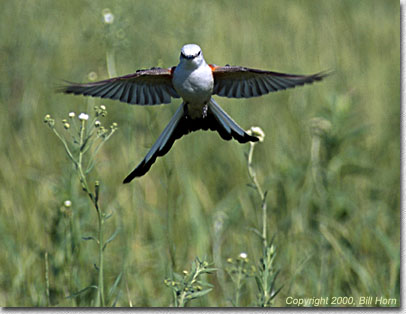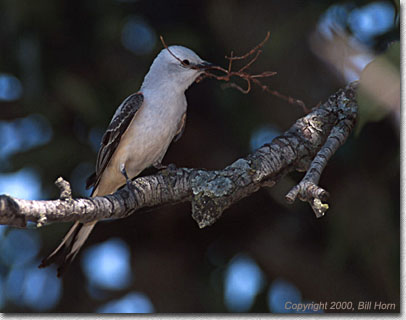|
|
 Feature Article... Sky Dance
Text Copyright and Photography Copyright Bill Horn
The male Scissor-tails begin their famous sky dance soon after arriving in early May. This elaborate courtship display is performed to attract the attention of potential mates. Having witnessed this behavior on a half -dozen occasions, I was determined to photograph the ritual this spring. (I spent no less than six days in the field during the spring of 1999 and failed to get images of the display.) This year, scouting an area near Stanley Draper Lake, south of Oklahoma City, I noticed several Scissor-tails along the roadside. The birds were perched in large isolated trees, where they prefer to nest. I set up my Nikon F5/600f4 on a Gitzo 1548 tripod about 30 feet from one of the largest trees and waited. As the sun peeked over the horizon, the birds began catching insects. The pair continued feeding for most of the day, but showed no interest in courtship. After a six-hour wait, I gave up. Hoping my luck would change, I returned to the same spot the next morning. I waited only 15 minutes when, as if by the queue of a motion picture director, the male commenced his courtship display.
To think that at the turn of the 20th century this wonder of nature was almost annihilated is disheartening. Throughout dust bowl and Great Depression years, the Scissor-tail was hunted to dangerously low levels. Driven by the European hat market, poachers killed the birds by the thousands solely for its tail. The tails sold for two cents apiece. Strict laws and a staunch conservation effort saved the Scissortail from possible extinction. Observing the nesting pair, I wished them Godspeed to proliferate their species, thus ensuring future generations could long enjoy the spectacle of the Sky Dance. Tech Data Nikon F5, 600/f4 AFI w/1 /1.4x TC, Gitzo 1548, Fuji Provia F, no filters used. BH-NPN |
|
|
 From its long tail, to its famous Sky Dance, no other Oklahoma bird is more striking and identifiable than the Scissor-tailed Flycatcher. One of only seven states where it nests, Scissor-tails usher in springtime in Oklahoma. In the warmer months they can be seen in the open prairies and on roadside fences. With a diet largely composed of agriculturally harmful insects, they are economically beneficial. So it is no wonder that the State Legislature adopted the Scissor-tail as the state bird in 1951.
From its long tail, to its famous Sky Dance, no other Oklahoma bird is more striking and identifiable than the Scissor-tailed Flycatcher. One of only seven states where it nests, Scissor-tails usher in springtime in Oklahoma. In the warmer months they can be seen in the open prairies and on roadside fences. With a diet largely composed of agriculturally harmful insects, they are economically beneficial. So it is no wonder that the State Legislature adopted the Scissor-tail as the state bird in 1951. Climbing to heights of 100 feet, the male Scissor-tail made a series of V-shaped flights, plunging down in an erratic, zigzag course, while uttering a rolling, cackling call. As a finale, he hovered about three feet above the ground for 15-20 seconds, exposing his magnificent forked-tail, salmon-colored flanks, and crimson-tipped shoulders. From her balcony perch in the tree, the female beheld this aerial ballet of unparalleled grace. She cheered him on calling out “cah-key...cah-key...CAH-KEY." While the male was too far away to photograph during most of the spectacle, I was able to shoot the finale, and the female as she observed his display. The female Scissor-tail was impressed, as soon after she began constructing a nest. When I stopped by again a week later, she was sitting on it, with the male nearby. I was fulfilled at last! I had captured one of nature’s most beautiful courtship rituals; one that is rarely photographed, and seldom witnessed.
Climbing to heights of 100 feet, the male Scissor-tail made a series of V-shaped flights, plunging down in an erratic, zigzag course, while uttering a rolling, cackling call. As a finale, he hovered about three feet above the ground for 15-20 seconds, exposing his magnificent forked-tail, salmon-colored flanks, and crimson-tipped shoulders. From her balcony perch in the tree, the female beheld this aerial ballet of unparalleled grace. She cheered him on calling out “cah-key...cah-key...CAH-KEY." While the male was too far away to photograph during most of the spectacle, I was able to shoot the finale, and the female as she observed his display. The female Scissor-tail was impressed, as soon after she began constructing a nest. When I stopped by again a week later, she was sitting on it, with the male nearby. I was fulfilled at last! I had captured one of nature’s most beautiful courtship rituals; one that is rarely photographed, and seldom witnessed.